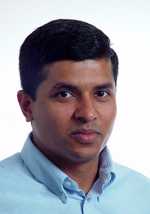 |
Department of Electrical and Computer EngineeringDepartment of Computer ScienceUniversity of Rochester, USA |
Gaurav Sharma is a professor in the Departments of Electrical and Computer Engineering, Computer Science, and Biostatistics and Computational Biology, and a Distinguished Researcher in Center of Excellence in Data Science (CoE) at the Goergen Institute for Data Science at the University of Rochester. He received the PhD degree in Electrical and Computer engineering from North Carolina State University, Raleigh in 1996. From 1993 through 2003, he was with the Xerox Innovation group in Webster, NY, most recently in the position of Principal Scientist and Project Leader. His research interests include data analytics, cyber physical systems, signal and image processing, computer vision, and media security; areas in which he has 54 patents and has authored over 220 journal and conference publications. He served as the Editor-in-Chief for the IEEE Transactions on Image Processing from 2018 through 2020, and for the Journal of Electronic Imaging from 2011 through 2015. He is a member of the IEEE Publications, Products, and Services Board (PSPB) and chaired the IEEE Conference Publications Committee in 2017-18. He is the editor of the Digital Color Imaging Handbook published by CRC press in 2003. Dr. Sharma is a fellow of the IEEE, a fellow of SPIE, a fellow of the Society for Imaging Science and Technology (IS&T) and has been elected to Sigma Xi, Phi Kappa Phi, and Pi Mu Epsilon. In recognition of his research contributions, he received an IEEE Region I technical innovation award in 2008 and the IS&T Bowman award in 2021. Dr. Sharma is a 2020-2021 Distinguished Lecturer for the IEEE Signal Processing Society.
Leveraging Old Tricks in A New World: Efficient Generation of Labeled Data for Deep Learning
In the emerging world of artificial intelligence algorithms and analytics, curated and labeled data is often considered the “new oil.” However, extracting this “oil” is often expensive and fraught with difficulties. Specifically, generation of labeled data can be labor intensive and tedious. Crowd sourcing can distribute the labor and mitigate the cost and tedium for some application scenarios. However, for other applications, such as medicine, the requirement of specialized knowledge and skills can make crowd sourcing unviable and generation of labeled data is therefore both expensive and limited, in volume and accuracy, by the availability of physicians’ time. The problem is even more acute for tasks requiring sample level labeling of large, high-resolution spatio-temporal datasets, for example, for pixel-level labeling of images for medical image segmentation. In this talk, through case studies, we highlight examples where creative use of conventional machine learning, computer vision, and image processing techniques allows us to efficiently generate labeled data for new applications of deep learning. The examples particularly highlight that these conventional tools continue to be effective and useful and will therefore co-exist symbiotically with modern deep learning methodologies.